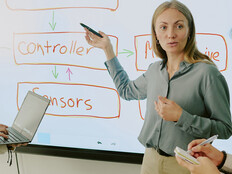Teaching the New Tech Way
Romeo and Juliet: The story of two star-crossed lovers, American and German, who met on Flanders Field in 1914 with the fate of the world hanging in the balance. Doesn't sound familiar?
It's by no means the way the William Shakespeare–penned classic is ordinarily taught, but there's nothing ordinary about Pinckney New Tech High School. The "school within a school" at Pinckney (Mich.) Community High School — one of seven in the Pinckney Community Schools system — combines a project-based approach to learning with cutting-edge technology. Pinckney New Tech also reimagines how its 400 students learn at almost every turn.
"When I first started teaching Romeo and Juliet, students would pick a part, we'd read the play aloud, and then we'd talk about it," says English teacher Chris Ozias, who has taught in the district since 1999 and joined the Pinckney New Tech faculty when the school opened in September 2010. "They'd take notes, and then maybe they took a test and answered some discussion questions."
At Pinckney New Tech, things are different. For example, ninth-grade English and history are taught jointly in a class called American Studies. Another difference is the easy access to technology: Every student has a notebook computer and can connect to the Internet anywhere on campus via a high-speed wireless network.
"Last year, my students created movie trailers updating the story of Romeo and Juliet to a World War I setting, which is the period they were studying in history," Ozias explains. "They shot the video using handheld cameras and edited the movies using software on their laptops."
After creating their films, the students were required to deliver a presentation to the class that would demonstrate their mastery of the subject matter and explain the connections between the themes Shakespeare explored in the play and the history of the war.
Pinckney New Tech is part of the New Tech Network, a group of schools in which one-to-one computing facilitates a highly collaborative, technology-centric, project-based learning instructional model. (By the end of 2012, the network expects to have 115 schools operating nationwide, up from nearly 90 in 2011.)
The point, says Pinckney New Tech Director Steve Keskes, is to create a school environment that mirrors the professional one students will enter once they graduate. "Pinckney New Tech is about more than just project-based learning," he says. "We're trying to prepare a 21st century workforce by creating a 21st century educational institution."
Professional Development Plus
To help make Pinckney New Tech a reality, Livingston County voters passed a $60 million bond initiative in February 2010. That money not only funded necessary improvements to district school facilities, it also enabled district officials to upgrade the wireless and network infrastructure and to purchase more than 2,100 notebooks — one for every student in grades seven through 12.
According to Tom McCurdy, the district's assistant superintendent for instruction, assessment and technology, a key part of making the New Tech model work was building in a commitment to teacher training from the outset. "That was one of what we called the 'non-negotiables' in the budget," McCurdy says of the focus on professional development. "We invested a substantial amount of money in our teachers up front, which became the core of New Tech. If you want to be a New Tech player, the commitment to training money has to be there."
In fact, the district employs a full-time specialist to show teachers how to integrate technology into their curriculum. But rather than force instructors to sit through formal classroom training, Instructional Technology Specialist Michael Partridge prefers to introduce tools to a select group of early adopters and then help them spread the word to their peers and other staff members.
"I've always tried to take a viral approach," Partridge says. "I spend time with a few teachers in each school and show them an exciting tool they can use in interesting ways that really fits well with the content they're trying to teach. I am hoping to infect them with an idea and let it spread as much as possible."
Partridge says his job is more about making teachers comfortable with new technology and being a resource that they can go to if they get stuck. "Often, my role is to go into a class and walk [students] through using video editing software with the teacher there," he says. "For the first hour, I'm teaching the class. During the second hour, the teacher is chiming in with comments. In the third hour, the instructor is doing most of the teaching, and by the fourth or fifth hour, I'm no longer needed."
Nothing but Net
While nearly every Pinckney New Tech project — whether it's a video or a podcast — requires some kind of technology, the biggest game changer in education, Keskes argues, is the always-available Internet.
"In the past, teachers or books were a student's only gateways to information," Keskes explains. "Now, students have the ability to uncover contemporary findings [online] on any subject and get multiple viewpoints on each of them."
In the process of learning how to research, organize and present this information, he continues, "they will find sources that disagree with each other, which teaches them how to think critically and evaluate which sources are trustworthy and which ones are not."
And if that means taking a radical approach to the classics, so be it. Instruction should change with the times, Ozias says.
"English in the age of the Internet should look different than it used to, because we have different ways of communicating now," he says. "Literacy is still as important as it's ever been, but there are many other ways students can communicate effectively via technology — and they need to learn them."
How to Make New Tech Work
Integrating an always-available Internet can mean changing how teachers teach. Here are some essential steps.
- Retrain your brain. Teachers need to become facilitators for knowledge, not primary sources, says Steve Keskes, director of Pinckney New Tech High School in Pinckney, Mich. That may require developing a broader awareness of the information resources that are available to their students, he adds.
- Use class time more creatively. Teachers can extend the school day by using digital tools to record video lectures or audio podcasts for students to watch at home. This, in turn, frees up precious class time for group discussion and collaboration, says Tom McCurdy, Pinckney Community Schools' assistant superintendent for instruction, assessment and technology.
- Be patient. It may take a while for all teachers to get up to speed on these efforts — and that's fine, says Michael Partridge, the district's instructional technology specialist. "We've just completed our second year of the one-to-one initiative, and I still have teachers telling me that they aren't really using this technology," he says. "I tell them, that's OK. When they're ready to use it, the technology will be there."








